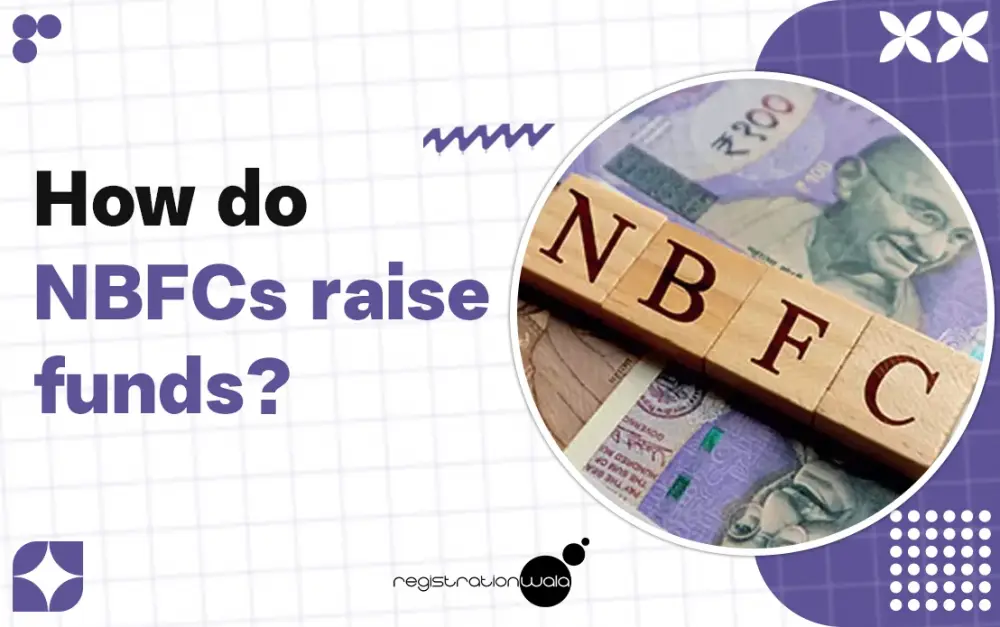How NBFCs Raise Funds
- June 07, 2024
- Registrationwala

- Home
- /
- Knowledge Base
- /
- News & other businesses
- /
- Blog
- /
- How NBFCs Raise Funds
How NBFCs Raise Funds
Non-Banking Financial Companies (NBFCs), over the years, have gained substantial prominence in India. These financial institutions bridge the gap between traditional banks and consumers, especially in areas where the reach of traditional banks is limited.
NBFCs offer loans and other financial services to different entities so that they can meet their funds requirements for business activities but have you ever wondered how the NBFCs raise funds? In this article, we will understand how NBFCs raise funds.
Brief Description of NBFCs in India
NBFC companies are financial institutions which offer financial services like loan, emi, etc. Most people have heard about NBFC companies like IREDA, Bajaj Finance, Muthoot Finance, Tata Capital, Mahindra Capital, etc.
Many people do not know how NBFCs are different from the traditional banks. Well, the difference between NBFCs and traditional banks is that the former cannot accept demand deposits while the latter can. Additionally, NBFCs do not have a banking license from RBI. Instead, they require NBFC registration.
In many cases, individuals and entities move to NBFC companies for loans instead of banks for easier approval with less paperwork.
How do NBFCs in India meet their financial requirements?
As their name suggests, NBFCs in India are not banking institutions. This means that they do not rely on CASA (Current Account Savings Account) deposits for raising funds to meet their financial requirement.
CASA deposits are only meant for banks, wherein the banks are provided with RBI license in order to accept funds from the public.
Since NBFCs do not have this luxury, they have to look for alternate sources of the money supply for raising funds. Let’s take a look at the various sources through which NBFCs raise funds.
Debt Instruments for NBFCs
One source through which NBFCs raise funds or capital is debt instruments, including debentures, bonds, commercial papers, and non-convertible debentures. In order to evaluate the creditworthiness of the issuing NBFC, credit rating organizations frequently rate these debt securities. Interest rates for the securities and investor confidence are impacted by these ratings.
The investment in corporate debt of NBFCs, in April 2024, increased by 23.5 percent Y-o-Y and 4 percent month-on-month to Rs 90,000 crore. As per the CARE data, the percentage of total corporate debt owed to NBFCs inched up slightly from 4.2% in April 2023 to 4.4% in April 2024.
Term Loans for NBFCs
Depending on the NBFCs' creditworthiness, various banks and other financial institutions offer them term loans. These loans come with a fixed schedule for repayment and are used for financing specific projects or working capital or fund requirements. The prevailing market rates and the NBFCs’ risk profile determine the interest rate for the term loans.
Equity Capital for NBFCs
Another source through which NBFC companies raise money is equity capital. NBFCs raise the equity capital by issuing its shares to investors. One such example is IREDA - an NBFC famous for funding green renewable energy projects in India. It is listed in the stock market, allowing it to raise funds.
Securitization for NBFCs
Illiquid assets of NBFCs, such as loans and receivables, are transformed into marketable securities through securitization. When these instruments are sold, the risk attached to the underlying assets is transferred to investors while allowing NBFCs to swiftly raise their capital.
Deposits for NBFCs
Certain NBFCs are allowed to accept term deposits from the public. These deposits serve as a stable funding source for NBFCs. The term deposits are subject to certain regulatory restrictions and are generally provided for varying periods of time, with interest rates based on the ongoing market conditions.
External Commercial Borrowings (ECBs) for NBFCs
It is not only the domestic market which allows NBFC companies to raise funds. NBFCs can also raise funds through external commercial borrowings (ECBs) from international markets. Through ECBs' help, NBFCs can enter into global capital pools and expand their funding sources. RBI has set certain guidelines for ECBs to the management of risks associated with foreign exchange.
Inter-Corporate Deposits (ICDs)
Short-term funds can be accepted by NBFCs from other corporate entities in the form of inter-corporate entities. These deposits are subject to regulatory caps and are used by NBFCs to meet their short-term liquidity requirements.
Conclusion
NBFCs play a really significant role in expanding access to financial services to individuals and entities, especially those in remote areas wherein traditional banks are not easily accessible. But like any company, NBFC companies also need fund requirements for their own activities and business growth.
Frequently Asked Questions (FAQs)
Q1. What is an NBFC Company?
A. NBFCs or Non-Banking Financial Companies are companies that provide financial services and products without acquiring RBI’s banking license.
Q2. Who supervises NBFCs?
A. The Department of Non-Banking Supervision (DNBS) is entrusted with regulating and supervising NBFCs under the chapters III B and C and chapter V of the Reserve Bank of India Act, 1934.
Q3. Who funds NBFCs?
A. NBFCs raise funds through various sources like private equity, banks, venture capital firms, debentures, securitization, commercial papers, public deposits and bonds.
- 870 views
